The humidity is amazing, and the presence of cloud cover suggests that yesterday may not be the last rain we see.
Arriving at Katherine, after roughly 2 hours on the road, we ate lunch in a park, which provided a home for an old steam locomotive with 2 flat-top rail cars attached.
From there we filled with fuel, and drove 29 km to the Katherine Gorge, a narrow high sided gorge with a 100 m wide deep green river. The climb to the lookout was very hot, but the kids coped extremely well. The view of the river, with lots of canoes and the cliffs was worth the effort.
Jacqui suited the kids up for a swim and I retreated to the car, only just in time, as a heavy rainstorm struck. When everyone returned to the car they didn’t bother to get in enjoying standing around in the cool rain.
Back in Katherine Jacqui looked a sight in her swimming costume, with an umbrella, as she visited the supermarket for bread etc.
In light, consistent, rain we drove to Edith Falls and set up camp in the wet. Anja and Lachlan frolicked in the mud, Anja claiming aboriginal ancestry at several points. No one argued. Bath time - cold showers - returned them to their original hue.
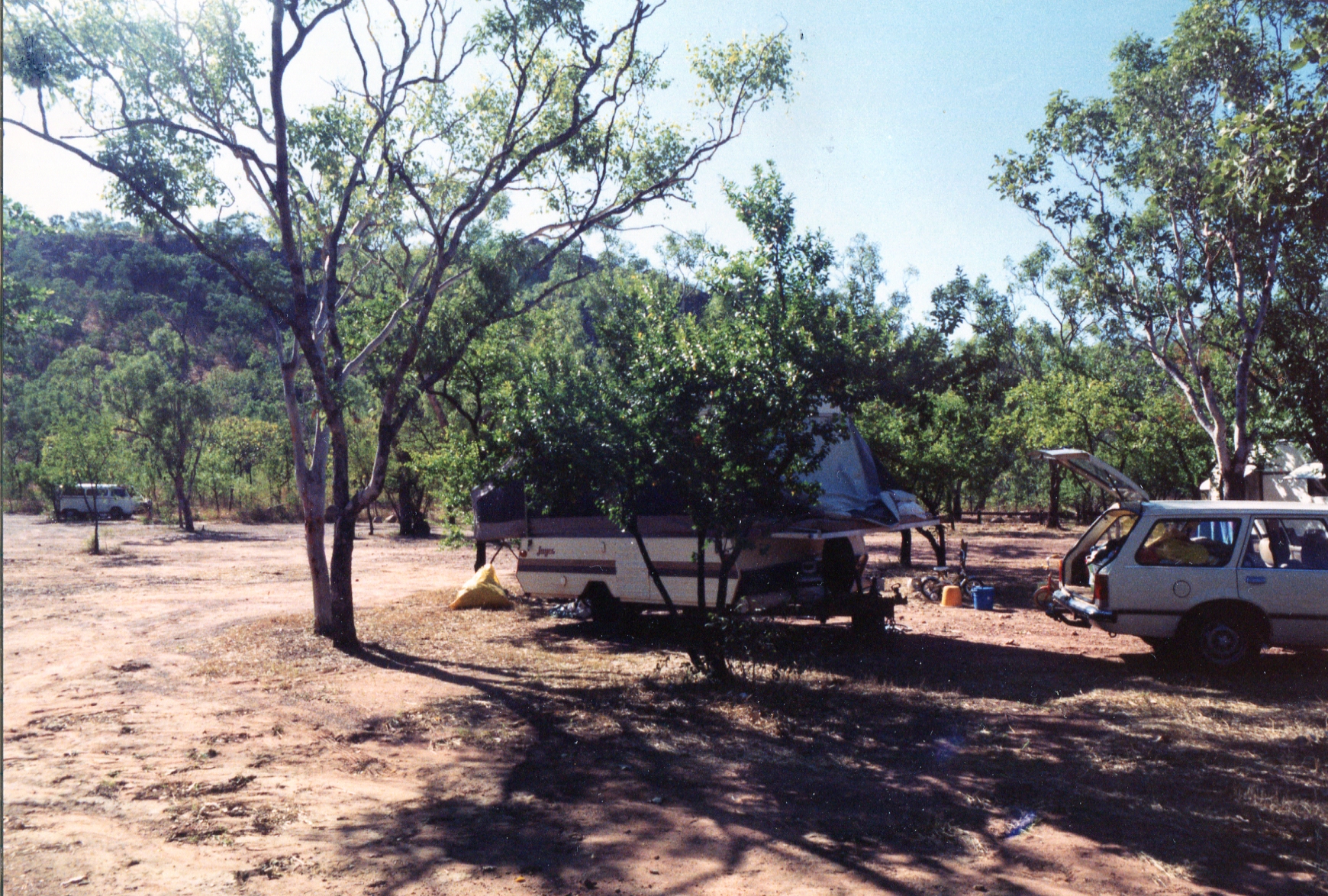
Our campsite at Edith Falls - an excellent freebie in the Katherine National Park
Monday, 7 May 1990
Edith Falls is actually a series of three falls, the water dropping about 60 m in total. At the base of each fall is a pool. We decided that we would look at the upper falls. The walk wasn’t steep, but the many loose boulders and relatively tall steps made it difficult in places for the kids.
At the upper falls, we swam for more than one hour in the beautiful freshwater. There was even the odd shallow section where Lachlan could stand. He used these as safe areas allowing him to swim 2 to 3 m across the deeper channels.
During the afternoon the clouds developed once again, promising more rain, however they never kept their promise, delivering a few drops at odd times. From the report of a newly arrived camper, we found that in Katherine they had received a number of days of heavy rain, similar to that of the previous day.
There were many new arrivals this afternoon, one group of four Toyota Land Cruisers with trailers formed up into a wagon square. Another was a long wheelbase land cruiser with trailer on a 14 day tour from Cairns into the Northern Territory. The tour group driver said he would return to Cairns and then do nine tours to Cape York during the dry.
We cooked our meal of chicken legs and potatoes over an open fire – the first time we’d cooked this way since Shannon townsite in southern WA.
Just as I was finishing the paragraph above, the couple from next door came by, saying they could see turtles in the river. Anja and Lachlan were still awake, so we left Rohan to sleep, and went down to the pool with a loaf of bread and a torch.
There were 20 to 30 turtles, the largest of which was about 30 cm in diameter. They were so intent on getting bread that they crawled all over each other, some sticking their necks out of the water to see more clearly. A few catfish were also swimming around collecting spare scraps of bread.
On the other side of the lagoon we saw the red eyes of freshwater crocodiles.
A letter written by Ian on this day
I think this letter was written for my colleagues at Barrenjoey High school - "Dear Everyone" is not very informative, however there is a reference to Alison Anderson as a student (at Barrenjoey High School in 1986) who may be remembered. The letter was returned to me and I stored it away, scanning it and including it here on 30th March 2021. There was another letter that has been scanned and added to a post for 12th March 1990.
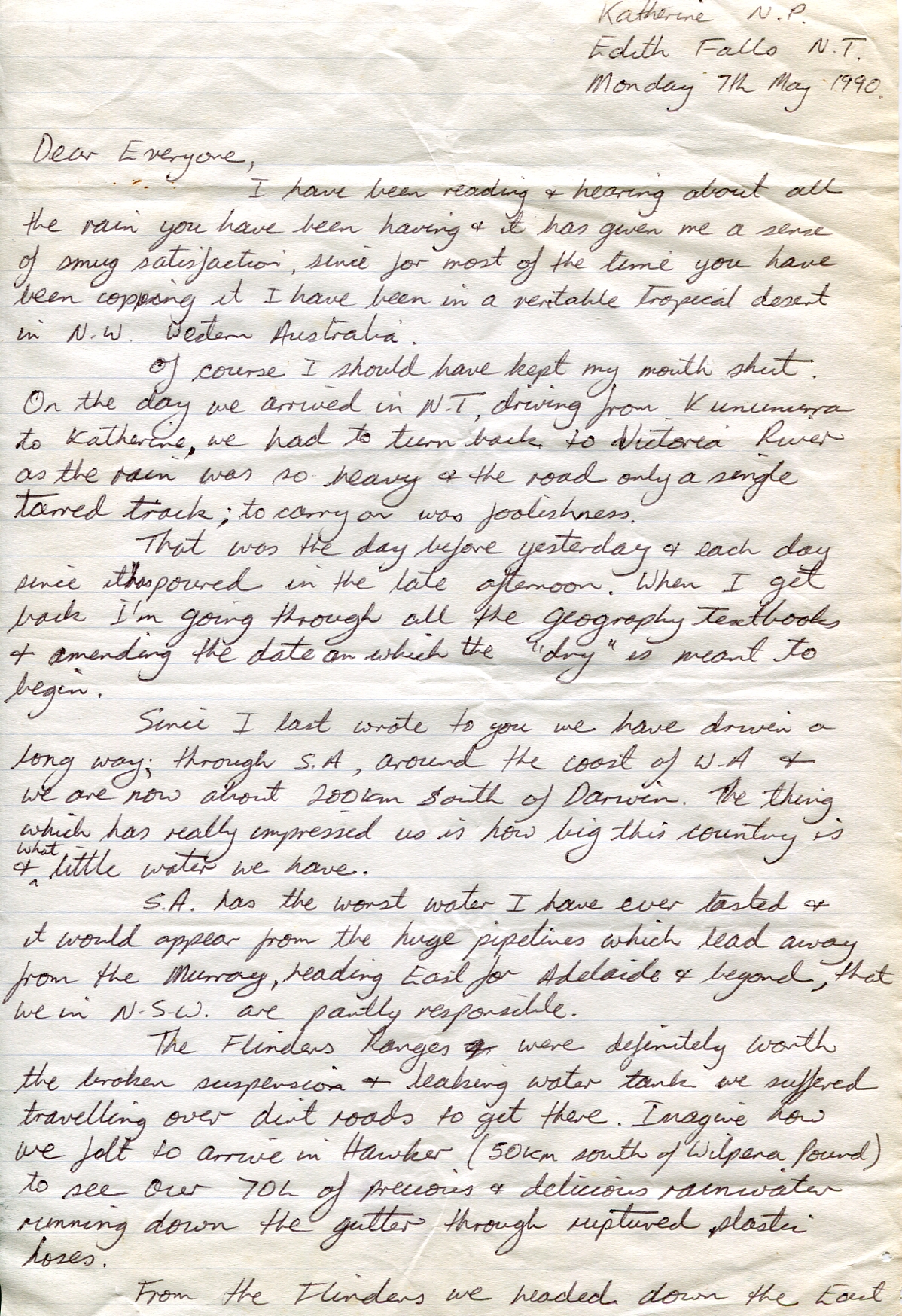
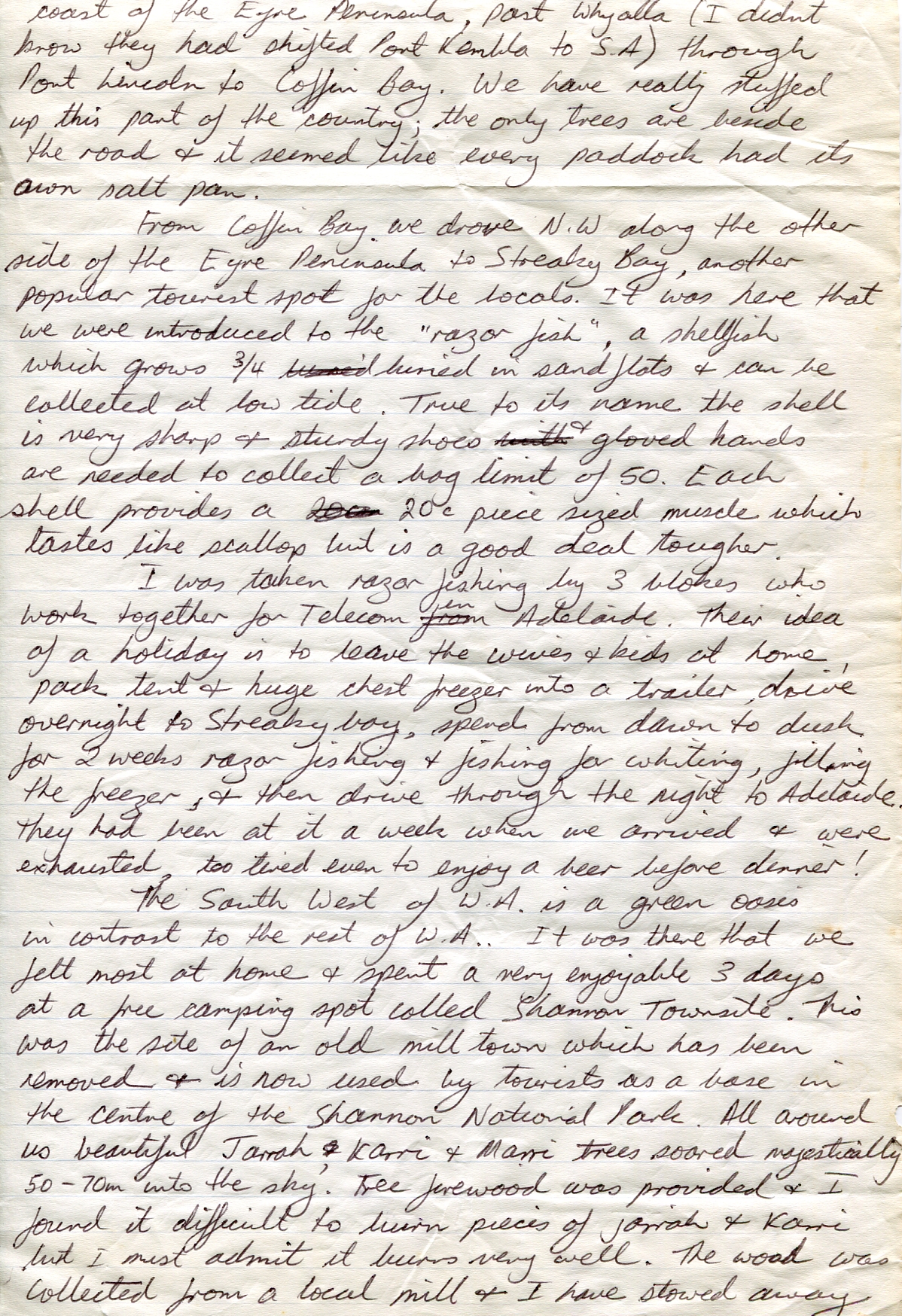
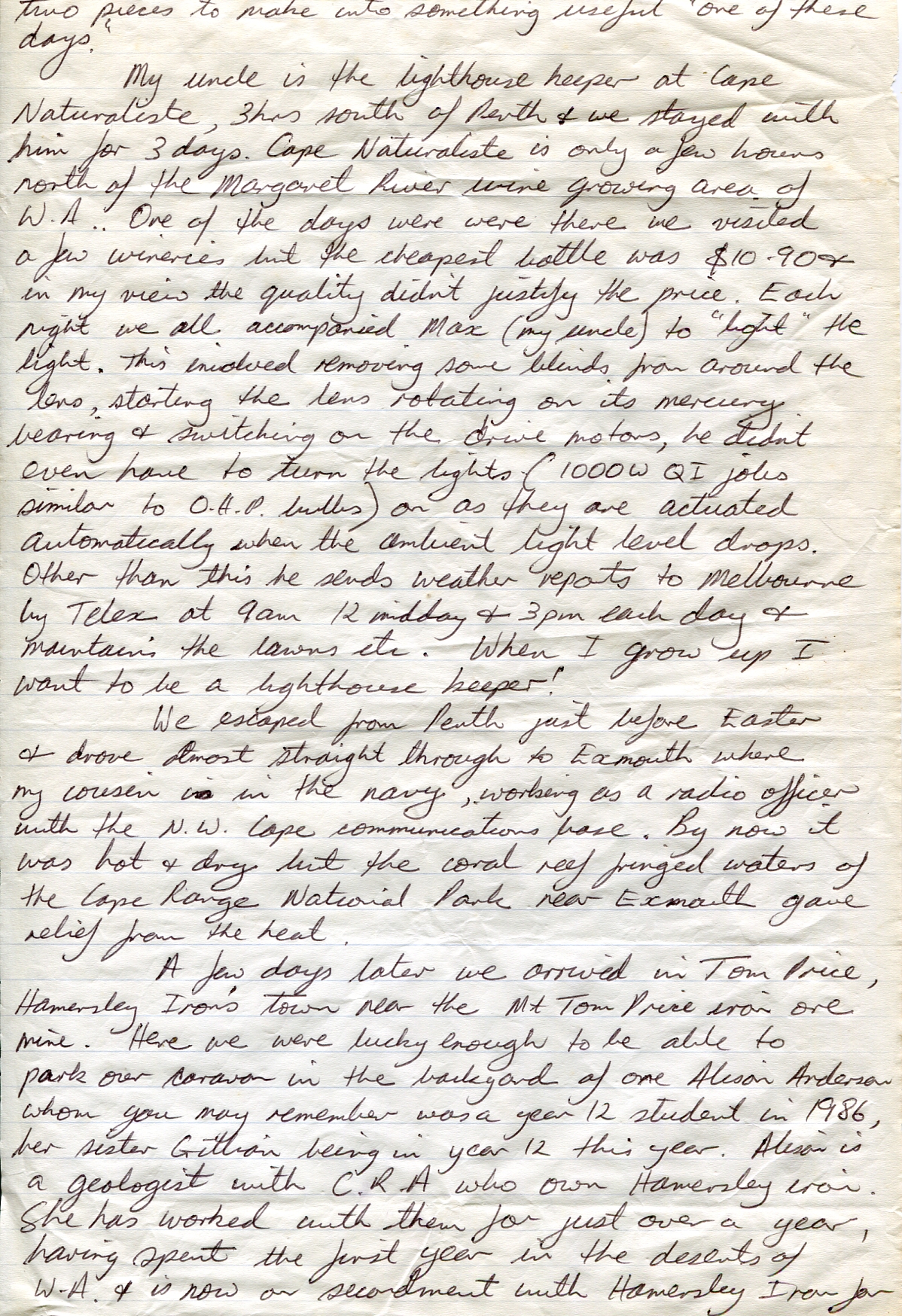
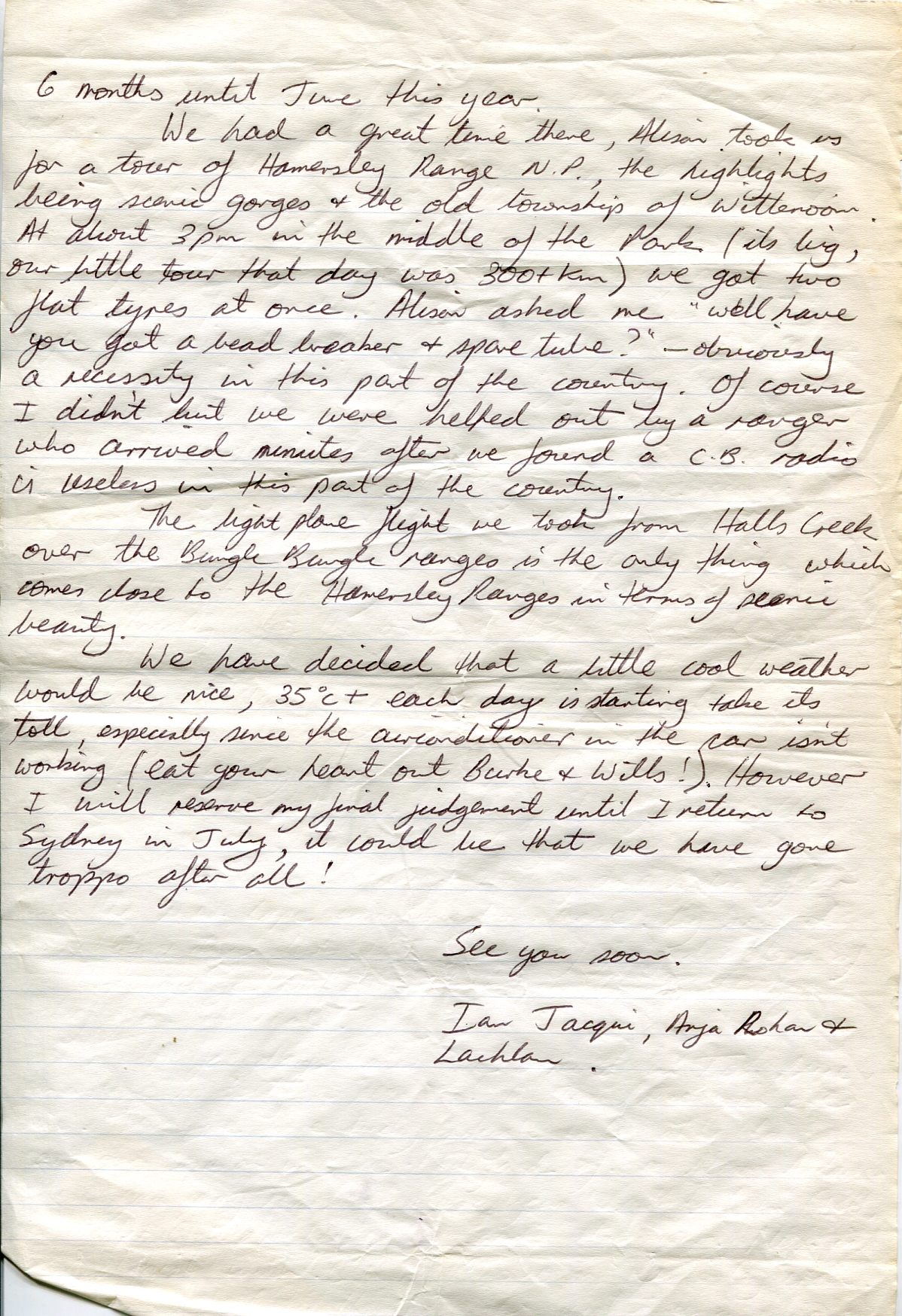
Tuesday, 8 May 1990 (two months to go today!)
During the morning, my 12 Volt soldering iron was put to use by both the tour group from Cairns and one of the four-wheel-drive owners. The tour group vehicle hit a cockatoo, which had lain, injured, in the space between the radiator and the bull bar. The first thing it had seen was the coaxial cable to the UHF antenna, which it had bitten through - so this needed repair. The other job was to repair a loose connection in the handset of a CB radio.
The rest of the day was spent swimming, fishing, and talking to other travellers as well as reading. The humidity wasn’t as high as yesterday's so, even though it was hotter with less cloud cover, it felt more pleasant.
After dinner we sat outside and spoke at length with Nick and Anne-Marie, two young British travellers who had been travelling the world since 1988. They had visited Europe, Egypt, India and Thailand before coming to Australia. Nick was a PE teacher and Anne-Marie a nurse.
Wednesday, 9 May 1990
The battery of the car was flat as we had run the lights of the van for three nights, without driving anywhere during the day to recharge it. Two ladies in a Daihatsu charade came to our assistance allowing us to jumpstart our car from their battery.
From Edith Falls we travelled north along the Stuart Highway, through Pine Creek where we saw a gold mine next to the road.
52 km south of Adelaide River, we turned off, taking a 67 km scenic route. I suppose the occasional steep hill, numerous flood ways and creeks with dense tree cover, as well as a narrow winding road, constitutes scenic!
After an expensive sandwich lunch at Adelaide River, we drove on to Batchelor, where we stocked up with bread, milk and fuel. Our plan, at this point, was to visit Lichfield Park and then press on for Darwin.
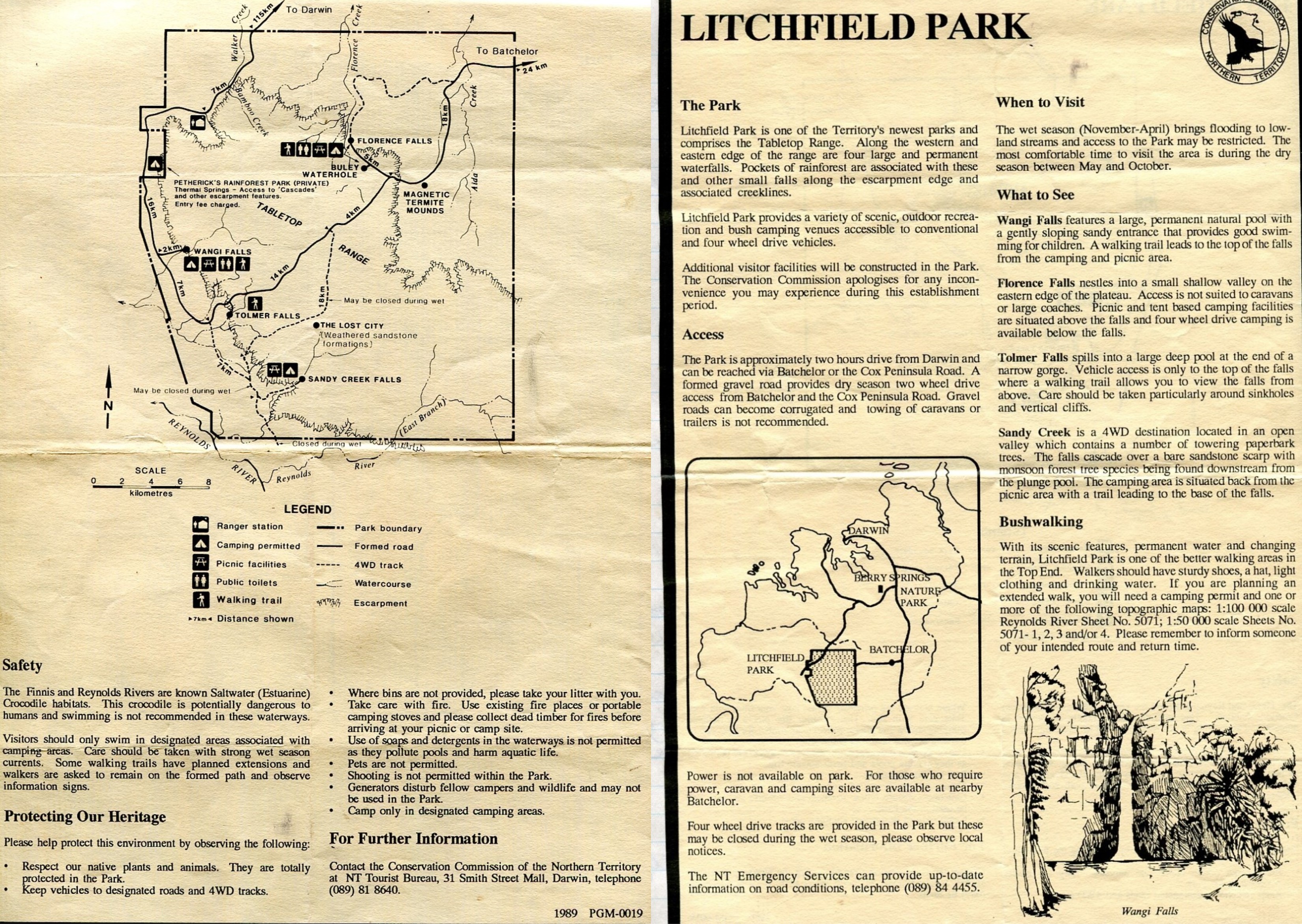
Litchfield Park is known for its waterfalls and after 40 km of, in places, poor dirt road, we stopped briefly at Florence falls. We fell in love with our next stop, Wangi Falls, immediately. A huge shallow pool with a sandy bottom receives the white water from twin waterfalls. One fall is quite large, and when I swam over to investigate, the force of the water kept me well back. Wangi falls is different from Edith Falls, for two reasons; firstly, these falls fall for at least 100 m in one drop and secondly the water is crystal clear!
We couldn’t drag ourselves away from such a spot, so we voted to camp in the spacious well-equipped camping area nearby. Eating dinner outside at around dusk was the last thing we did outside, because soon we were being eaten alive by mosquitoes.
I spoke briefly to a bloke on a BMW K100 who was the mine geologist at the goldmine at Pine Creek. He works 3 ½ weeks straight, then has one week off to tour on his motorbike. Shortly after dark we saw him leave. I suppose having no tent and sleeping with the mossies wasn’t his idea of fun! Nor was it mine.
Thursday, 10 May 1990
Waking up just after dawn, we were greeted by the sight of literally thousands of mosquitoes waiting on the fly screen to eat us! Even at 9 AM there was still uncountable mossies waiting.
This video is version 2 because YouTube rules that kids swimming, without tops, violated their community standards.
The morning was occupied by walking up the sandstone escarpment. The track is mainly crude steps fashioned from the local rock. I was proud of the kids who walked, without complaint, up the 300 m long track. At first we walked in the cool and shelter of rainforest broad leaved plants, but for the cool and dark, we paid the price of mosquitoes as an escort. About halfway up we emerged from the rainforest into the typical dry scrub clinging tenaciously to the steep scree slope and the joints of the sandstone cliffs.
At the top, the view repaid the effort. To the west, north, and south, the scrub covered plane stretched uninterrupted, while below the intense green of the rainforest was broken by the mottled green/yellow of the pool. Lachlan and I walked close to the edge of the falls, between the four streams, and looked down on the swimmers below, who seemed to be mysteriously suspended by the invisible water.
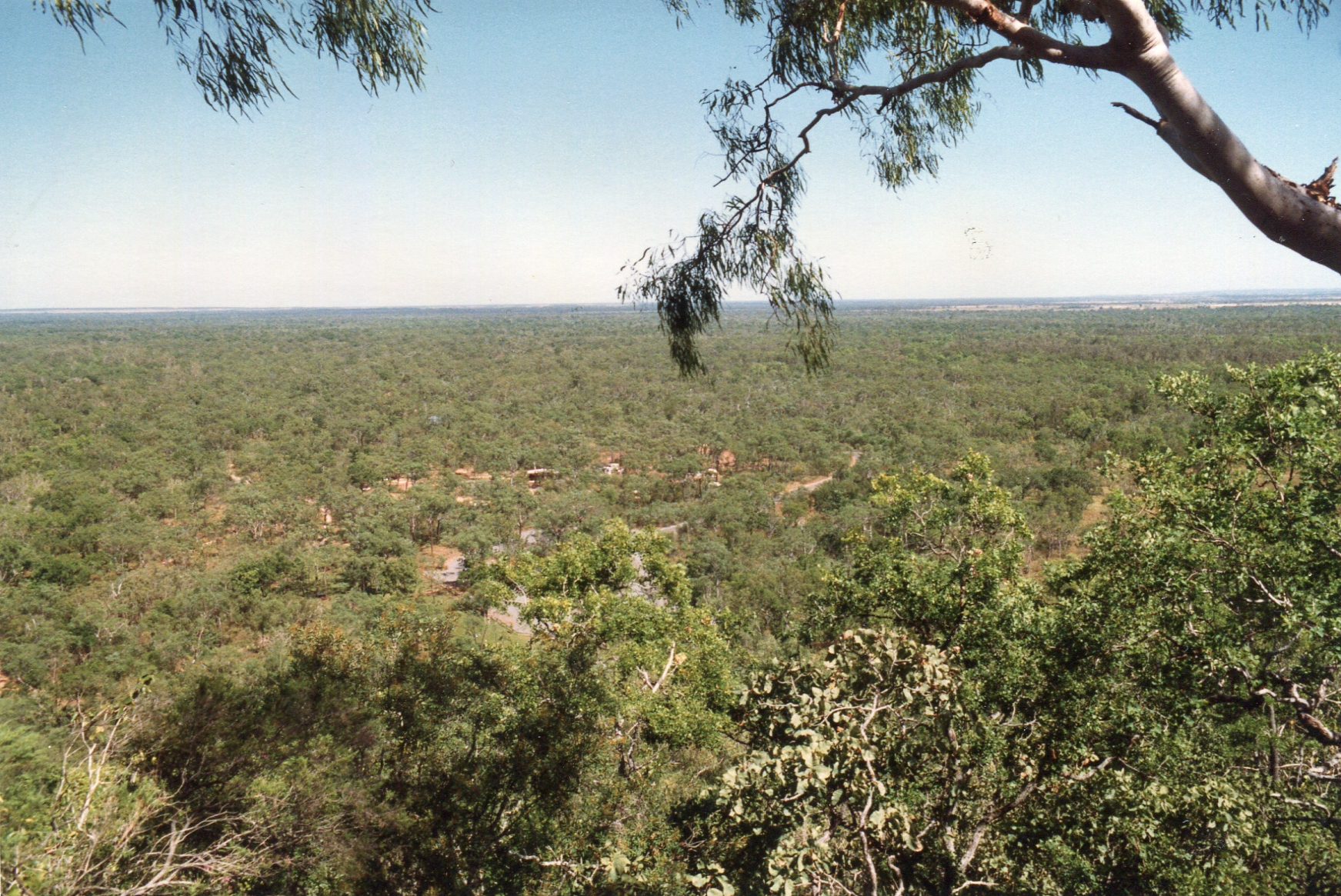
Our campsite at Wangi Falls as seen from the top of the falls.
Walking down was no problem. We hurried through a lunch of cruskits, beetroot and salmon (Mum would have felt at home as this is what they usually had for lunch on most days!), before gathering swimming gear and returning to the pool.
For the next three hours we luxuriated in the water or reading in the shade by the pool. I took mask and snorkel and spied some large fish, possibly barramundi, around the submerged roots of the palms which rimmed the pool. The crystal clear water gave excellent visibility for snorkelling.
Two things surprised me: 1) there were pools of cool and warm water, sufficiently different in temperature, to produce a heat haze effect; 2) the water around the main falls, which fairly powered down, was turbulent and aerated to a depth of only a few centimetres. Many fish swam into the stream near the falls probably waiting for food.
Reluctantly we left at about 4 PM, heading back through Batchelor for Darwin.
Arriving at Palmerston shopping centre just on dusk, we shopped (late night shopping was on this day). Lachlan was stunned we spent $141 on groceries. Next, we booked into the Palms caravan park, needing a magnetic key to get through the gate. This caravan park is mainly a home for permanent residents. We had to go five rows back before finding a vacant spot. We set up camp in the dark.
Friday, 11 May 1990
After the inevitable washing plus the unusual task of coping with Rohan, who had the runs, it was into town for a shopping day.
The thing which struck both Jacqui and me, as we drove into and around this city of Darwin, was how modern and progressive it appears. We were both pleasantly surprised!
At the post office, where we were able to park only 20 m away, we picked up a post pack and letters from Mum and Dad, unfortunately no tape from Howard. (2020 note: Howard Oberg had been copying video from our camera cassettes onto VHS and returning the camera cassettes for us to reuse). The kids were all as happy as Larry to receive Batman and Penguin clothes. They would have put them on in the middle of the post office had we allowed it. Jacqui was pleased to receive a new skirt as we were looking for one at the time. We didn’t attempt to read Mum and Dad’s letters as they were too long and there was too much else going on.
Next, we booked Adelaide River and yellow Waters cruisers at the Northern Territory tourist bureau. They were helpful, but it surprised us that Kakadu, being an Australian government park, had zero information available at this tourist centre. And, finally, the bookshop 20 m further down the mall, yielded the first book of Lord of the Rings for Lachlan and a copy of Field guide to Australian birds for Alison Anderson.
At this stage, we were all hungry and hot. Jacqui and I had been arguing heatedly about what to write in the book we had bought for Alison.
So, lunch in the park and time to cool down literally and metaphorically was needed. Here we spent the best part of an hour reading Mum and Dad’s 40 page account of the Northern Territory and Singapore trip. Mum’s account is detailed and informative giving a good idea of sights, smells, sounds and people. Dad wrote briefly and expressed an affection for us and a longing to be reunited, which we all feel. While we were reading, Lachlan found a coconut in a husk.
Then it was back to "work", purchasing T-shirts and other gifts before moving to the waterfront where we picked up prawns for dinner. At Beaurepaires we were quoted $83 for a replacement tyre for the caravan, but we got one for $75 at Tom’s tyres down the road.
Doctors Gully is famous for its nightly fish feeding, so we went along to see it for ourselves. Visitors feed white bread to the thousands of fish who come each day to be fed. The major species present were milkfish - algal feeders that grow up to 1 m long and look like kingfish - catfish and diamond mullet. The kids had a great time, getting wet and feeding the fish.
Back at the van Jacqui cooked up a superb Nasi Goring. Yum!
Saturday, 12 May 1990
I wanted to wake up early, but 5 AM!!! That’s what time an argument, 50 m down the lane, woke us both (and others). A husband and wife had a beauty, which apparently came to blows.
Anyway, we had no problem leaving early enough to make our 10:30 AM appointment with the Adelaide River Queen, 33 km off the Stuart Highway on the way to Kakadu.
Here the Adelaide River is a 100 m wide, yellow snake with prickly mimosa, bamboo and acacia pressing right up to the water’s edge. Even 92 km from the sea, there is still a strong tidal influence in the 100% freshwater river.
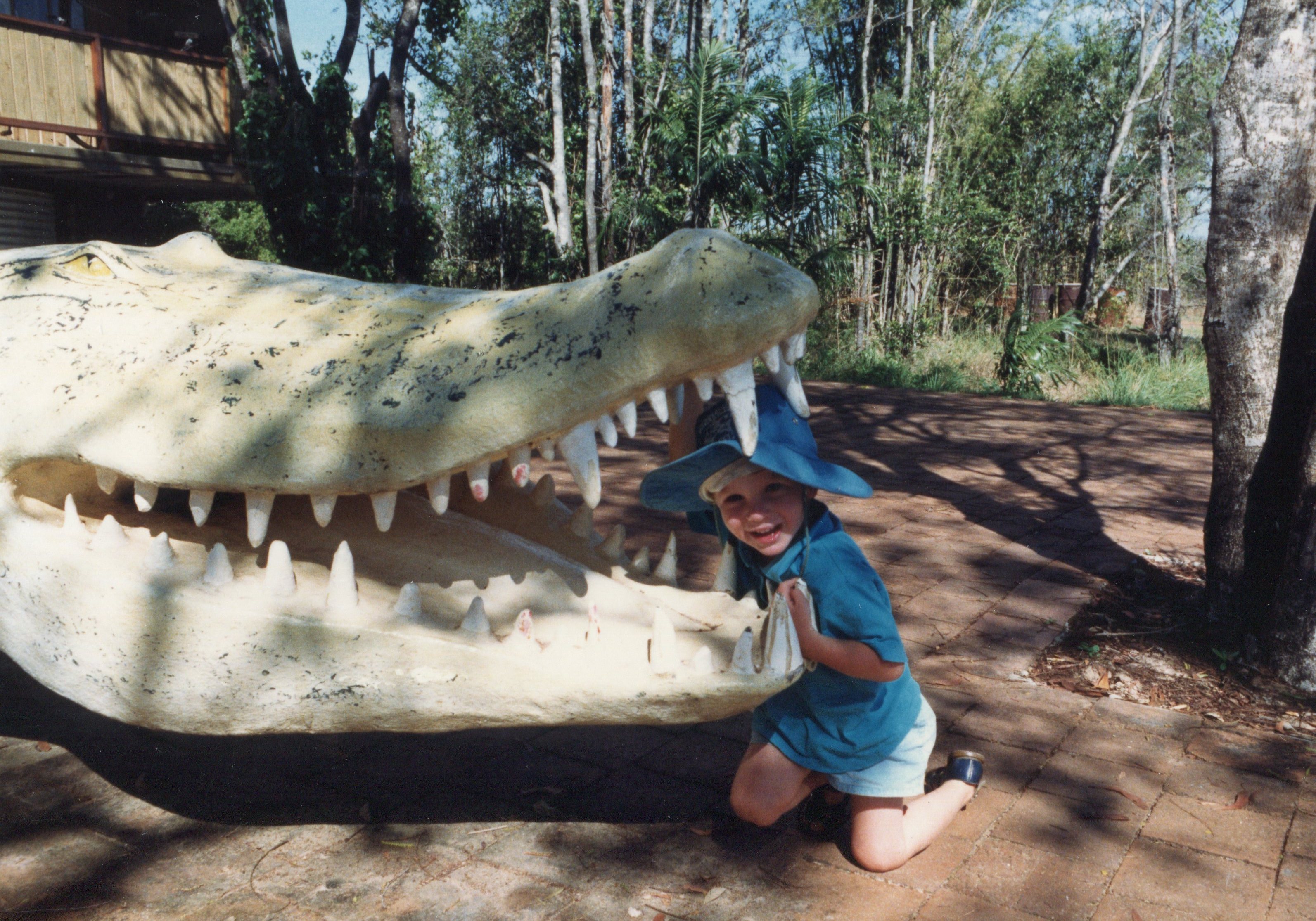
The Adelaide River Queen is a large flat-bottomed barge, with 2 stories. The lower story is glassed in, while the upper is open yet shaded. Driven by twin six-cylinder Volvo Penta diesels, driving Hamilton Jet drives, the craft can move quickly when all goes well
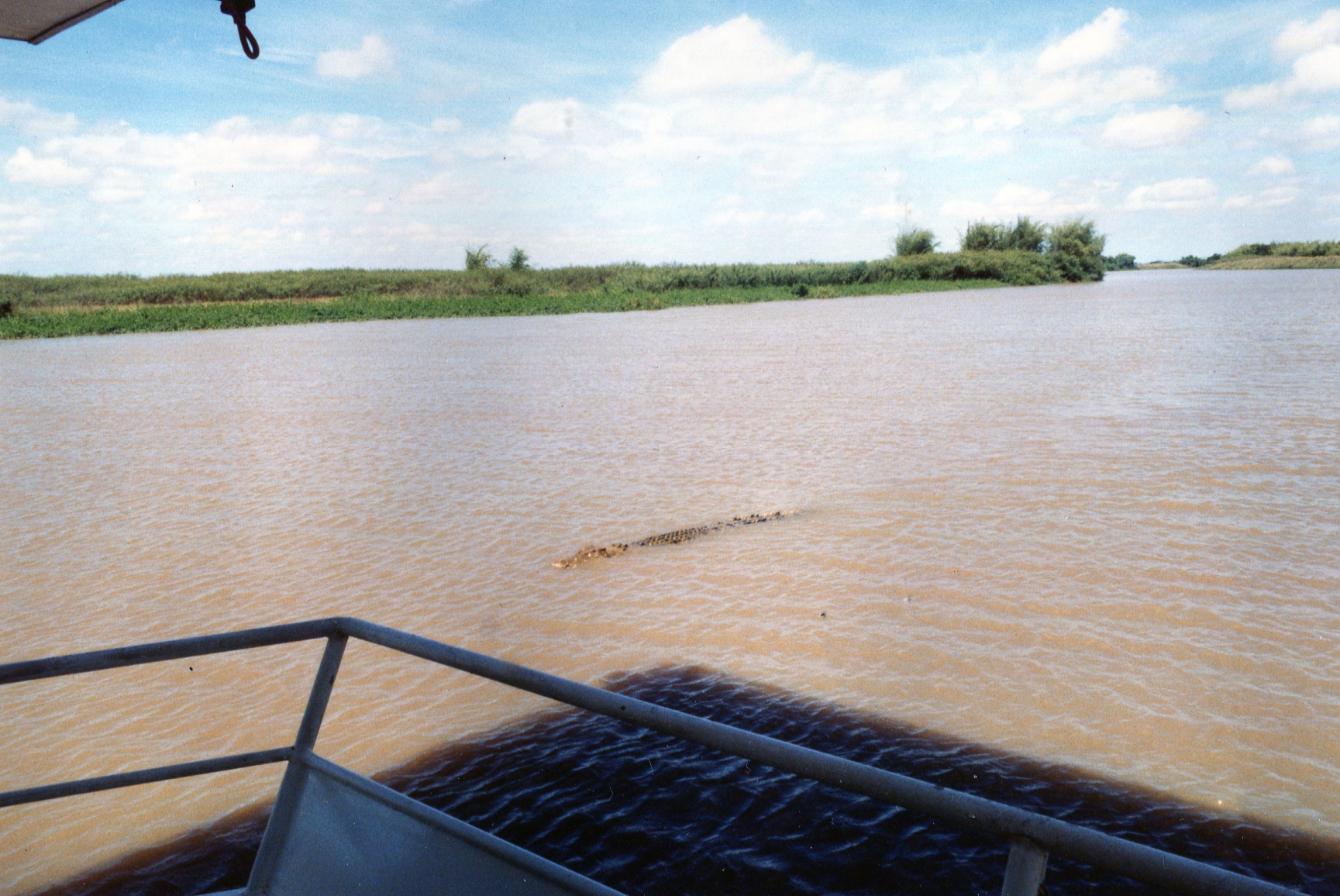
We could see why the skipper on a cruise called crocodiles "loggerdiles"
As soon as we moved into the middle of the stream the first of many crocs appeared. The young female crock soon obliged the 50 or so tourists by jumping for a piece of bony meat held by light string tied to a heavier loop, suspended in turn on a long pole. This was held out by a crew member on the upper deck. We saw crocs between two and 4 m in length jump for the meat so that their back legs were emergent. Great stuff!
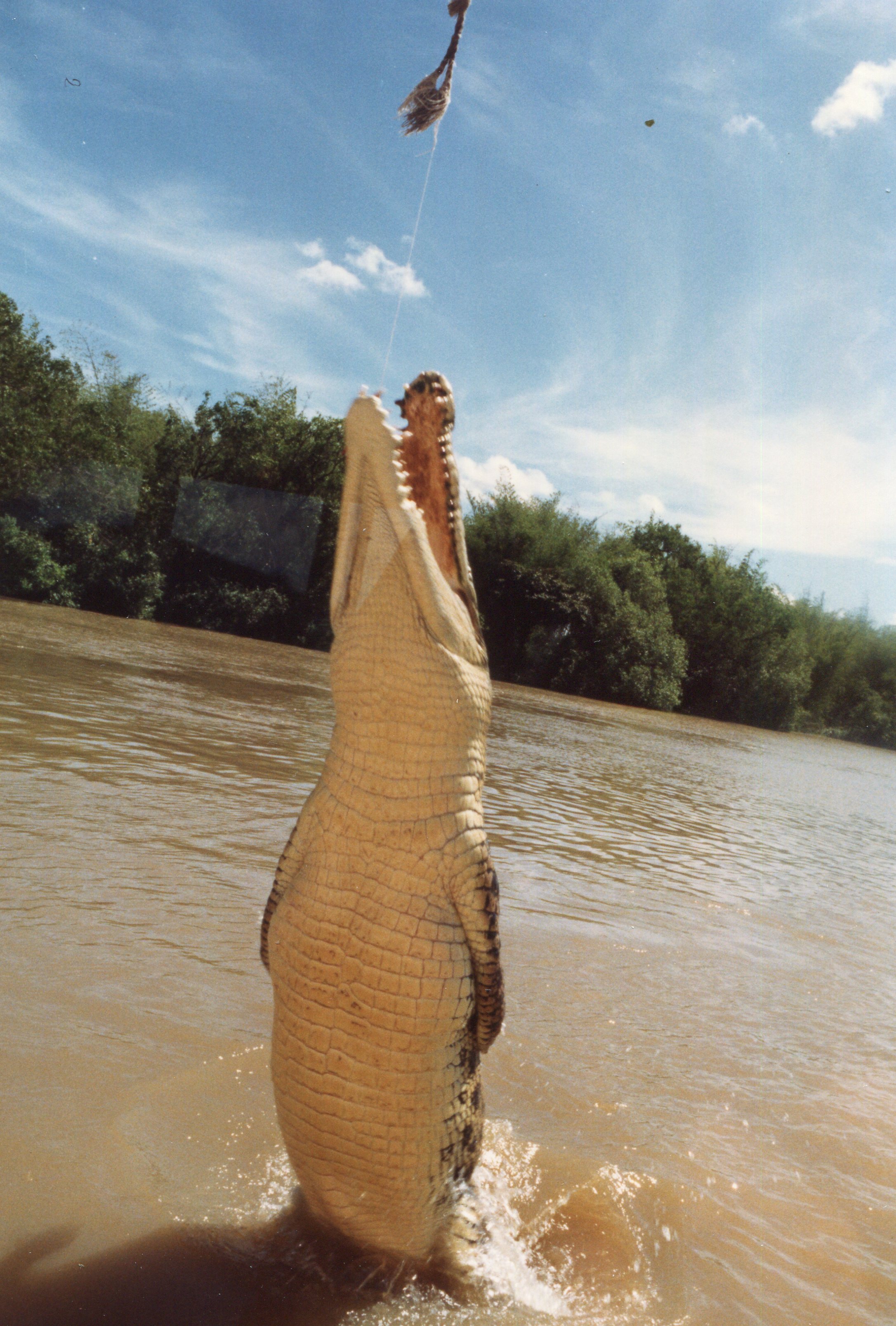
Spectacular and scary athleticism!
It may have been coincidence, but shortly after running over some floating bamboo, the starboard jet cease to function, reducing both top speed and manoeuvrability for the rest of the trip.
In addition to feeding crocs, we visited a crocodile nest where we saw the remaining two of 40 hatchlings (about 20 cm long) and disturbed a colony of fruit bats. Much to the horror of one female crew, a pair of sea eagles began flying amongst the bats, with gourmet intentions. However, they were unlucky. The same sea eagle demonstrated its acrobatic ability, by plucking a piece of meat suspended by string from a branch of a dead tree on the bank. Later it did the same trick grabbing a piece of meat from the boat. Other the birds seen were Ibis, egrets and bee eaters.
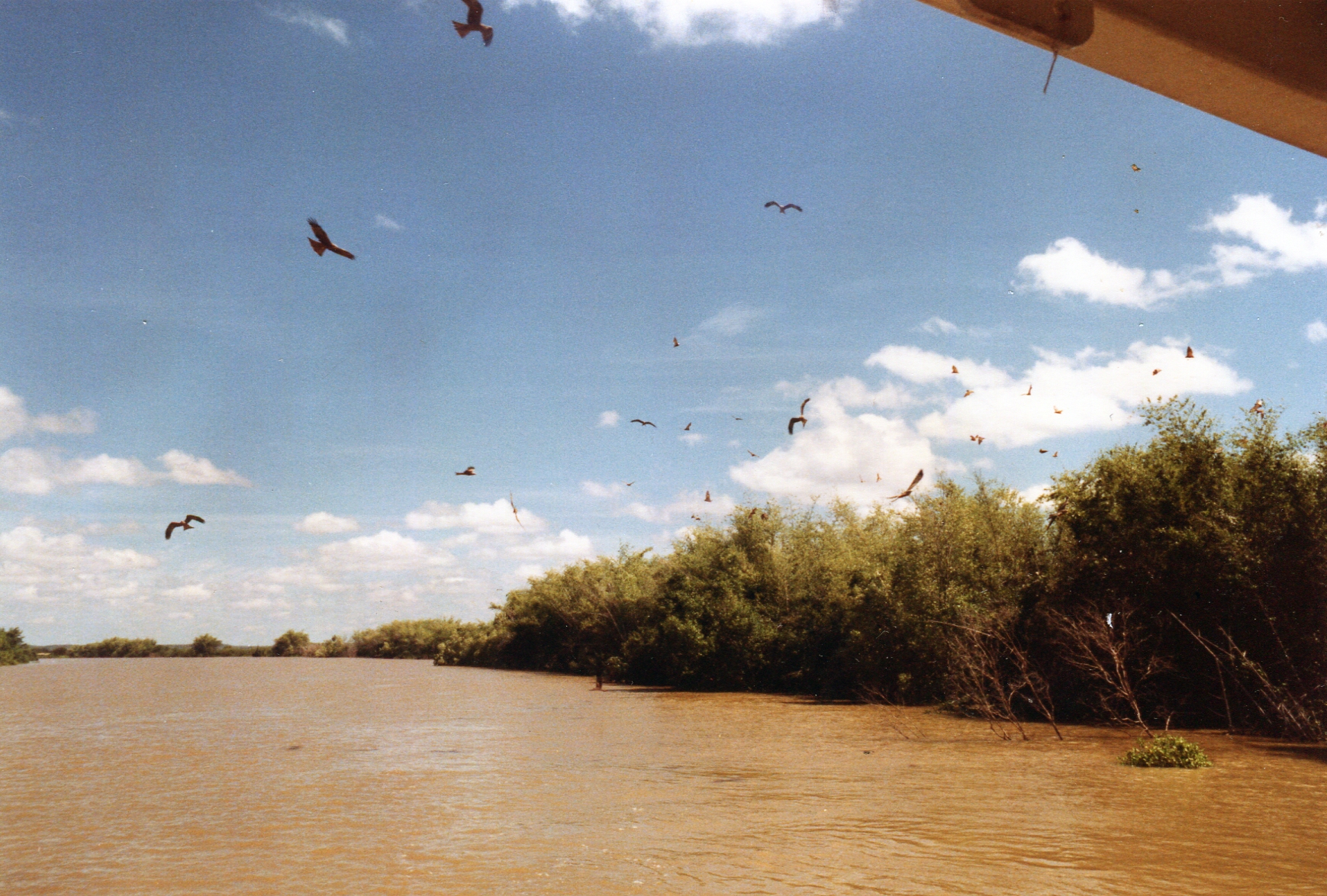
Kites, flying foxes, and an eagle over the Adelaide river
Returning to the wharf at 1:30 PM, we emerged from the air-conditioned comfort of the boat, and headed through basically monotonous country to Kakadu. There we visited the visitors centre and then set up camp at Muiriella campsite.

At about 9 PM a generator started, and since we were in a no generator area, I walked over and politely asked how long the generator would be run for. I found out that the guy running the generator was the manager! Obviously chastened, he turned it off 20 minutes later.
Sunday, 13 May 1990 (Mother’s Day)
Our day began at around 5 AM when a clearly audible conversation began in the small Jayco not 10 m from us. Apparently, a group of overseas tourists in a Hi Lux four-wheel-drive, owned by an Australian from Melbourne, were overwhelmed by the mosquitoes. They had been unable to sleep, walking back and forwards, covered by blankets, to escape being consumed. The constant sound of feet on gravel had awoken the two blokes in the Jayco, who then invited them inside their ‘van, out of the reach of the mosquitoes.
The Jayco blokes were from Maitland NSW and spoke so fast that the foreigners couldn’t understand a word they said. The invitation went something along the lines of “Doyouwannacomeinorwhat?” Three times the Swedish girl asked her companion “what did he say?” with an appropriate Swedish accent (you'll have to do that!), before they managed to translate and accepted the invitation to take shelter inside.
After a leisurely morning, we turned up on time for the Yellow Waters boat tour which leaves from the Cooinda Four seasons resort. Here we swapped a Northern Territory tourist bureau voucher for our ticket.
The vessel we were on was a 38 foot long punt, capable of seating 67 people, and driven by 2x50 hp Mercury outboard motors. An awning made the hot sun bearable, although for most of the morning we were shaded by clouds
The cruise snaked through freshwater mangrove, pandanus and waterlily lined wetland, along a plant-free brown water channel, which we were later told was up to 4 m deep in places.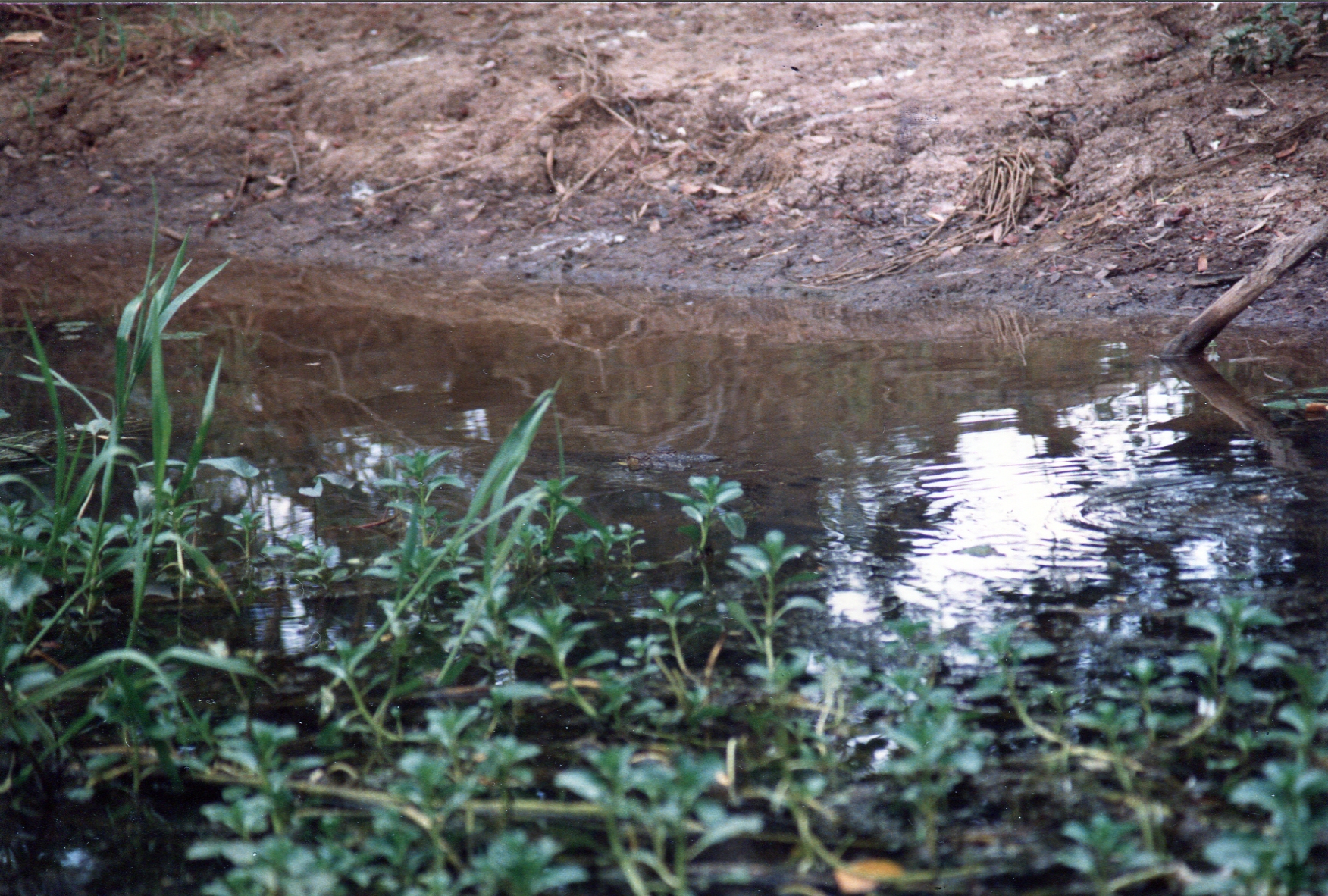
Not all crocs were easily spotted - can you see the one to the right in the image from our Yellow Waters cruise
Most of the cruise was spent stopped, with young bearded Clinton, giving informative talks on the wildlife resort. The wildlife included jabiru, egrets, herons, bee eaters, turns, ducks, pelicans, sea eagles, kites and Jesus birds. On the reptile front we saw crocodiles which (he called loggerdiles) - all salties ranging in length from 2 to 4 m some of which were in and some out of the water. A few barramundi also made their presence known by jumping and thrashing about near the water’s surface. I couldn’t see any of these big fish as the water is opaque. The cruise was an appropriate length at around 1 ½ hours, especially with the kids in mind.
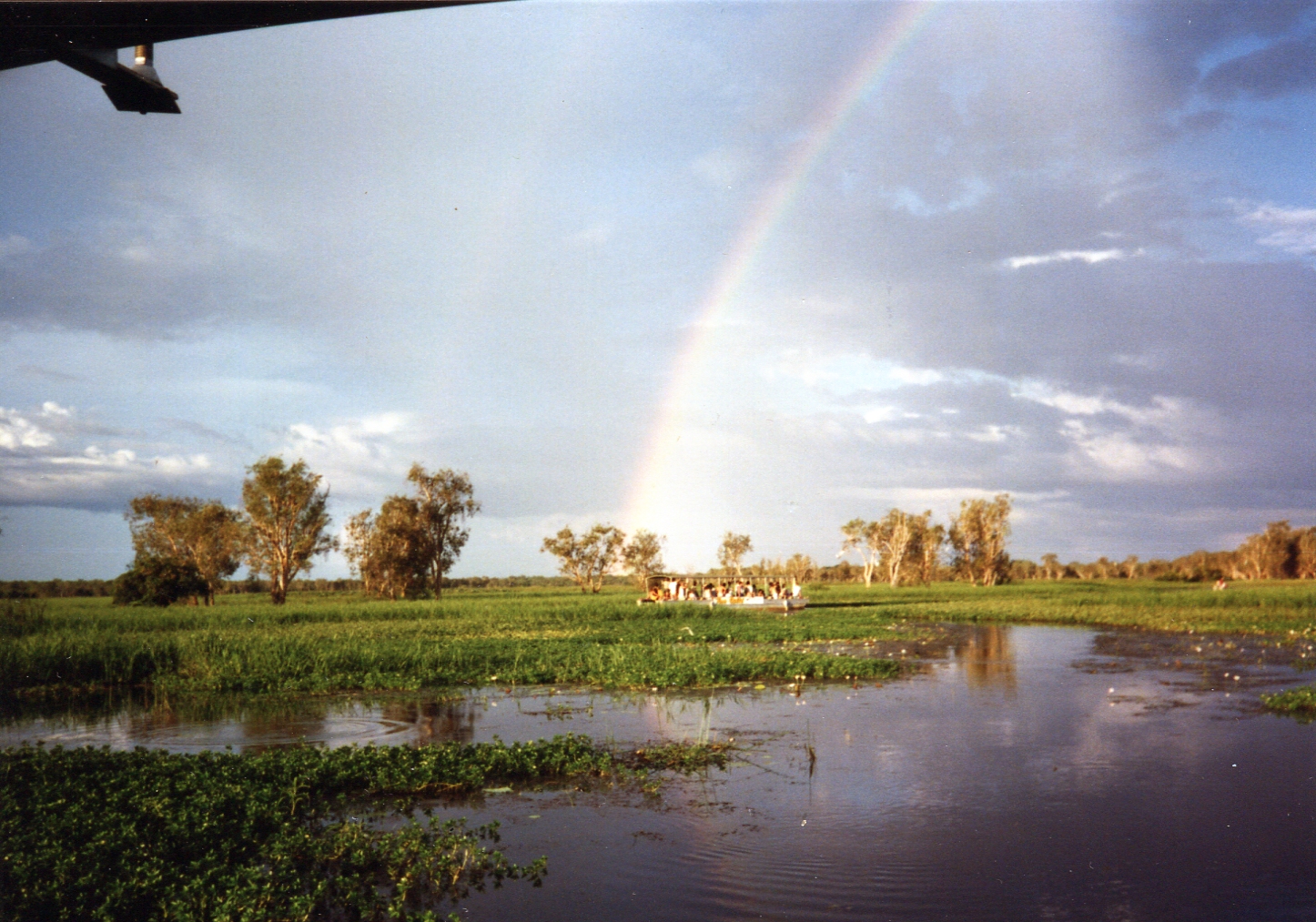
Yellow Waters cruise near Cooinda in Kakadu NP
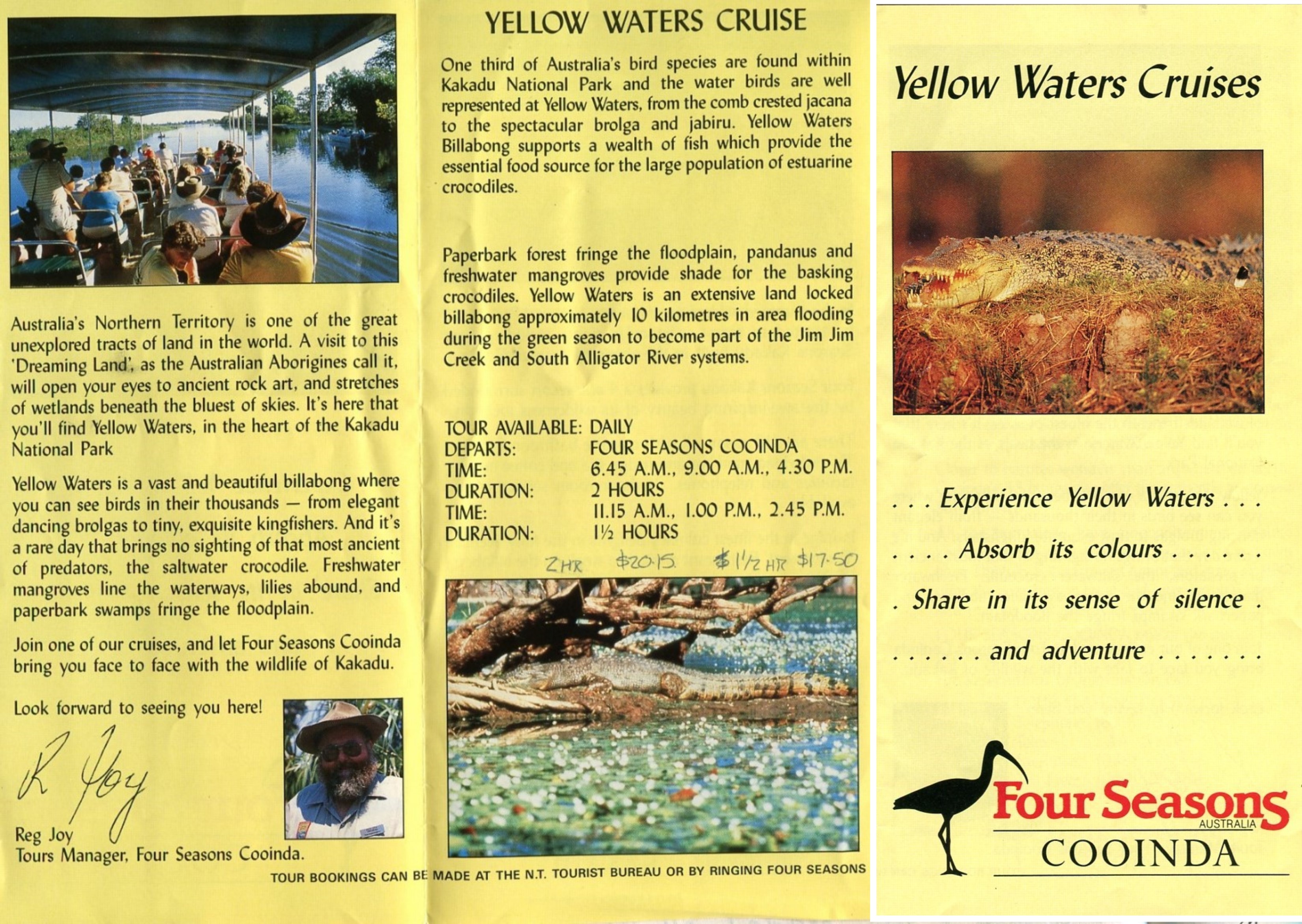
Essentials, such as bread milk and ice creams, were purchased at the Cooinda store before filling with fuel and phoning home. We found Nicky (Jacqui's sister) is definitely taking a job in Perth. Back at the van for lunch and lounging around during the hottest part of the day.
At 4 PM we were on the road, driving north to see the Ubirr art site, about 60 km away. Part of the road was dirt, and much to Lachlan’s delight, we crossed 2 fords, where water was over the road, and the river bottom rough.
At Ubirr the walk to the paintings was short, about 100 m, but this was too much for Anja and Rohan, who had been sleeping in the car. Both insisted on being carried, Rohan was “the worst”, not even allowing us to put him down to view the art.
The paintings were worth seeing, painted in red ochre on flat surfaces protected by overhanging parts of the cliff. The clearest example is in the “x-ray” style, depicting fish, often barramundi, and other animals. Other styles besides X-Rays were present including one example of very primitive bee’s wax painting.
From the main gallery, we walked and scrambled up improvised steps to the top of a sandstone outcrop. The total climb was about 50 to 100 m, made easy by the differential weathering of the rock and the natural bedding that had produced natural steps.
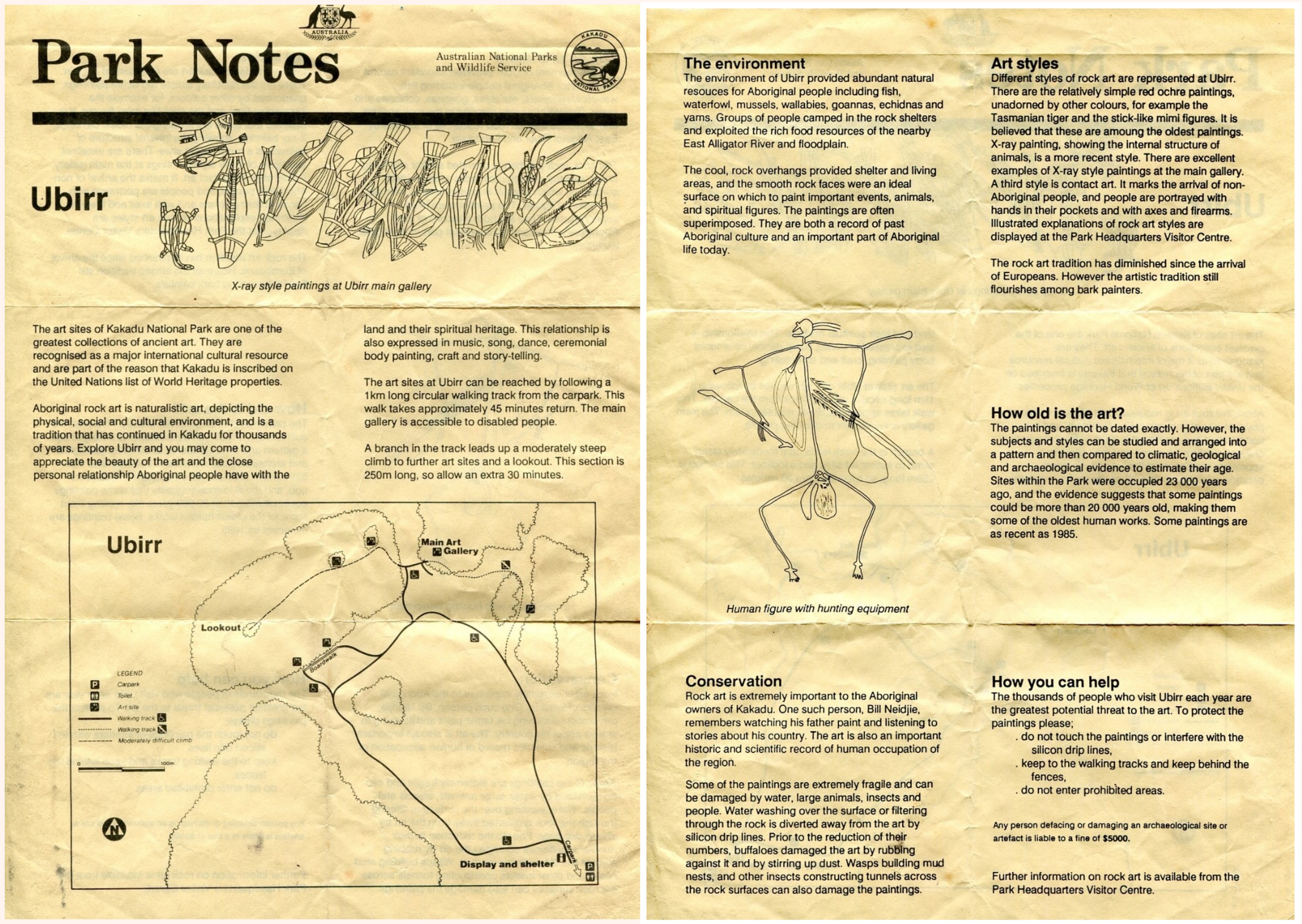
The view from the top was worth, not only the climb, but also the entire trip to Kakadu - heat, humidity, mozzies and all.
To the north and west, and immediately below us, was a low-lying swampy area covered in unbroken, uniformly green, grass. Here and there groups and corridors of trees provided a haven for birds, and a few roundish reed beds dotted the landscape like checker pieces. Pathways had been trampled in the smooth looking grass by, we were told, water buffalo.
Beyond the bowling green smooth area, scrub and trees reappeared and stretched to the horizon over a flat plain. To the north-east, east and south, the sandstone plateau of the escarpment makes a hesitant start, with outlying columns similar to the one on which we were standing, dotting the landscape, some tree covered, others bare.
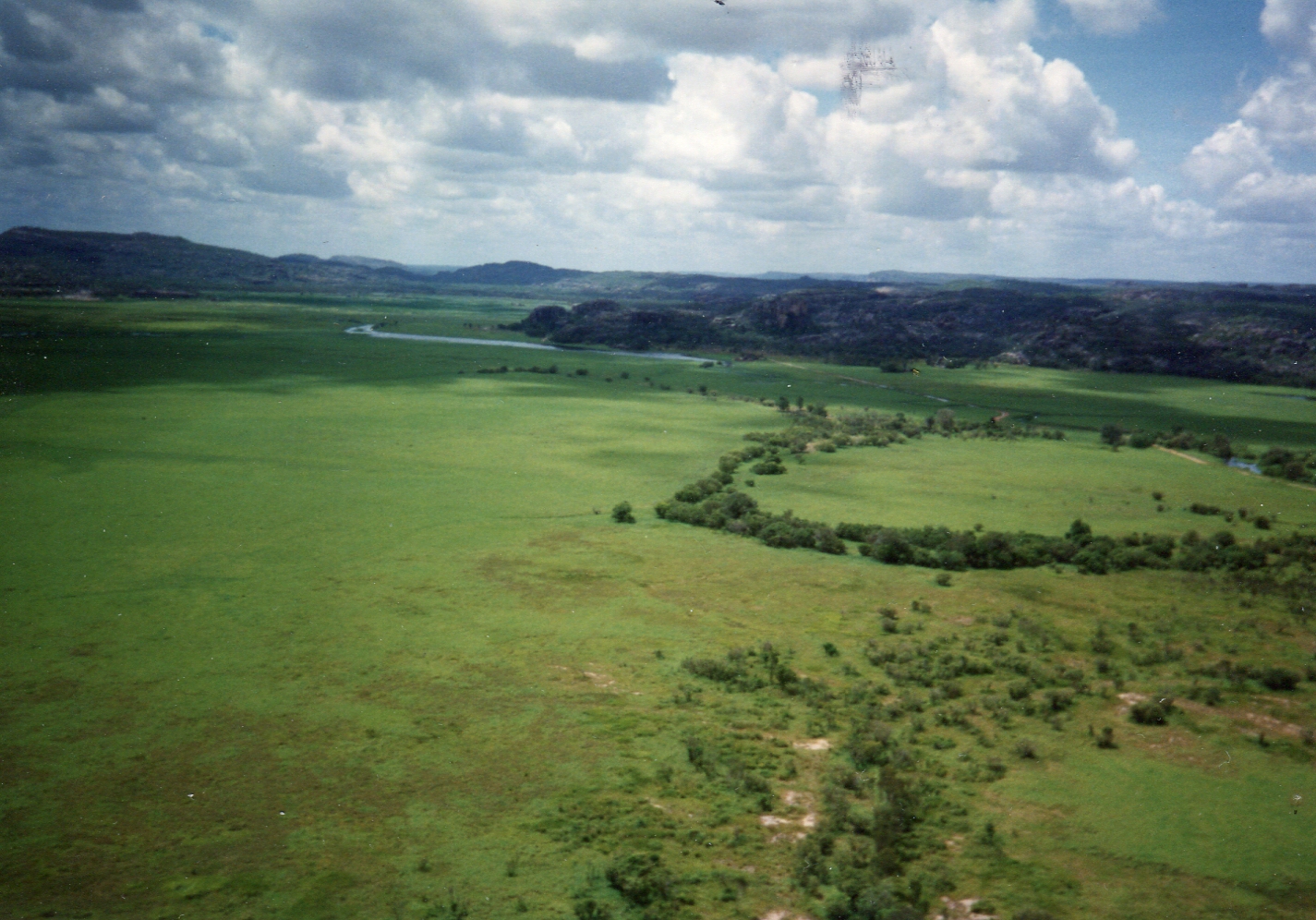
Elaine and George's photo of the land as seen from Ubirr
Most of the sky was covered by clouds. To the north 2 thunderstorms provided a dark grey background which often makes green areas intensely coloured when they are illuminated by the setting sun’s rays. Along with about 10 other people, we stayed to soak up the view while the sun set. The kids jumped from rock to rock on the plateau's rough surface.
During our wait for the sun to set, Jacqui and I spoke to 2 Swiss-German women who were on a two-month holiday. They had spent the first month in Thailand and during the second would be travelling from Darwin to Perth in an old HQ Holden station wagon.
The view from this point alone, made me feel that the “World Heritage” status of Kakadu is justified. I had a sensation of well-being, similar to that I experienced while looking at the southern ocean from the cliffs south of Coffin Bay in South Australia.
Monday, 14 May 1990
After packing up the 'van we drove about 30 km to Nourlange rock. This is the site of another art gallery like Ubirr, but significantly different. At this site, the massive sedimentary rocks, which overlie the older basement rocks, rise imposingly 100 to 150 m above the surrounding plain. The rock is mainly a conglomerate in which the pebbles are white, angular to sub-angular, quartz. The rock is also unusual in that it shows little internal structure, without the finer grained layers we saw at Katherine. Because joints in this rock are widely spaced, at around 5 to 10 m, the resultant joint blocks are huge, producing their own series of “mountains”, where the joint blocks crashed down onto the plain from their position in the cliffs.
The gallery of aboriginal art and occupation sites are found in, and between the displaced joint blocks
A path leads around the sites, here smooth earth, there crude rock steps and, in the occupation sites, raised wooden walkways. Interpretive and informative signs give information on the art, most of which is recent x-ray style.
At one site, we had the opportunity to give our opinion on the paths, signs etc. when a young lady asked us to help her complete a survey for the Northern Territory Parks and wildlife service.
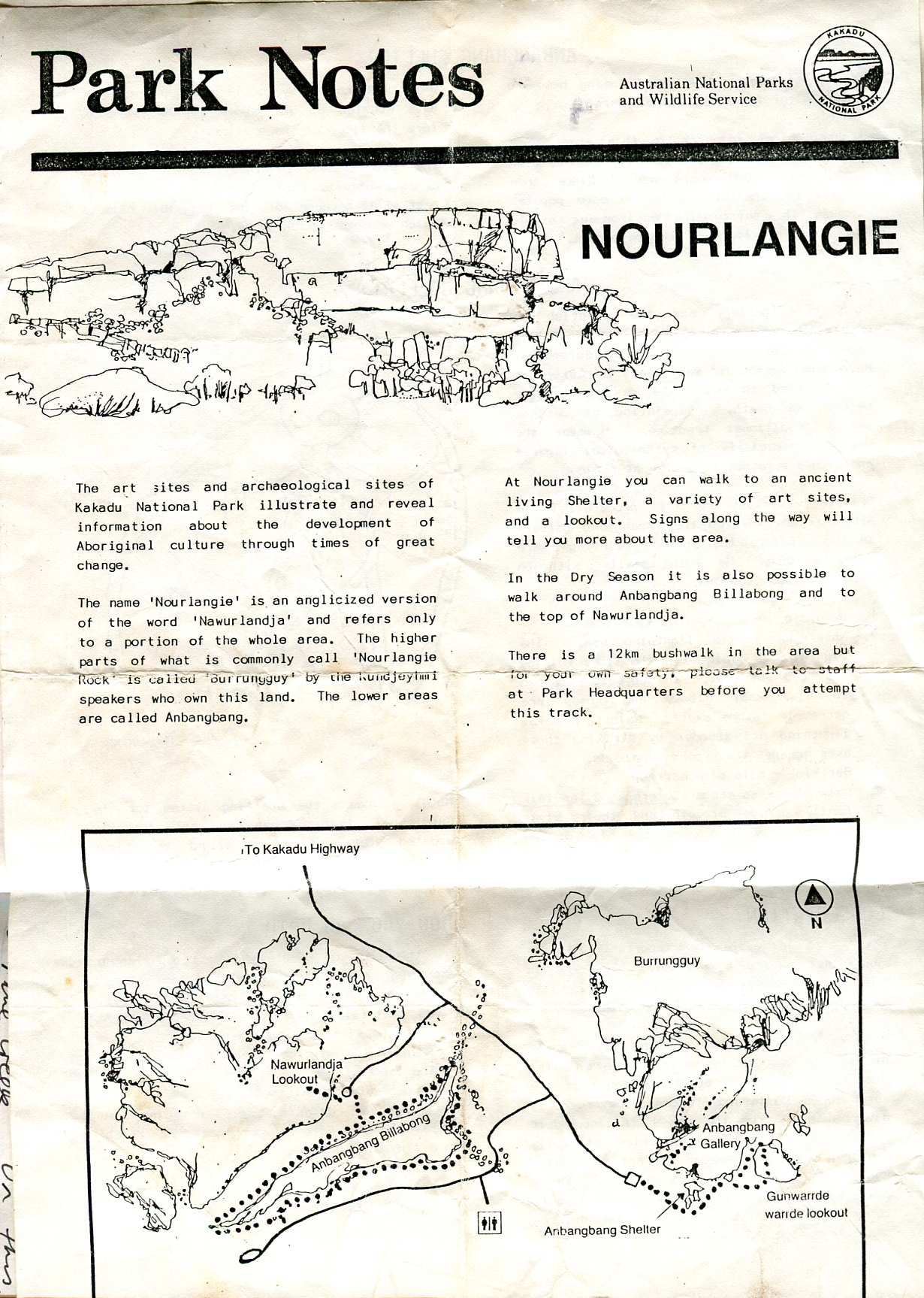
Rohan was grumpy again, so Jacqui and Anja went back with him to the car. Lachlan and I continued on a short walking loop to a rocky outlook. Here we spent half an hour talking to a group of travellers who had been with us the previous evening in Ubirr. One of the young women we met had a sketchbook and she showed us some of the sketches she had done since leaving England.
We had lunch at the car park, bought ice creams at Cooinda and then headed down Kakadu Highway towards Pine Creek. On this, mostly dirt, road we crossed several creeks and the South alligator River. After all the hype we had been told about crossing this river, it was an anti-climax. The water at the crossing was only 20 cm deep and the bottom was smooth, making driving across easy.
At Pine Creek there was the inevitable stop for fuel, before turning south on the Stuart Highway once more for Katherine and then to Elsey Park. Fruit and vegetables were bought at Woolworths Katherine.
About 40 km south of Katherine we were flagged down by a paunchy aboriginal man. His car needed a jumpstart, or so he thought. Out with the jumper leads, which I had fortunately placed in an easily accessible box in the back of the car. His big car had a V8 engine, which made the jump start leads smoke when we attempted to start his car. But there was no sign of firing. Soon, we decided to swap batteries and mine made his car turnover much more quickly, but still no start. Apparently, they had stopped to add water to an overheated engine and, as it was idling, it just stopped.
It soon became clear that they had absolutely no knowledge of things mechanical. For example they frequently said “it must be the starter motor” (the starter motor was working perfectly); “have a look at the timing” (the car had been running perfectly before it stopped); “try using a screwdriver on the starter motor”.
In the end, I disconnected the fuel line to the carburettor and not a drop of fuel was to be seen. By now, we had had enough - it was nearly dark, the kids were hungry and Jacqui had decided we were about to be mugged.
So, we took Sophie Hogan, one of the car’s occupants, to their community 29 km off the main road and continued to Mataranka, and then to the turn-off for Elsey Park National Park. Here, we saw a sign which said “no camping” contradicting the pamphlet we had collected at the NT Tourist Bureau. We decided to camp anyway!
After 11 km of two wheeled dirt track we had no difficulty identifying the camping area. The lights of 4 other groups of campers were clearly visible. What puzzled us, and lead to flights of fanciful imagination, was what the other campers were doing. All we could see, across 50 m of scrub, was a fly screen walled tent, inside of which sat eight elderly people under the light of the fluorescent tube. Some of our more interesting conjectures were that they were a religious sect, carrying out worship, or that they were involved in some sort of orgy (evidence for this couldn’t be found as they were all fully dressed and no one appeared to move).
I found out the next day what was going on: all the male members of the group were receiving haircuts!
Tuesday, 15th May 1990
We may not have been bothered by mosquitoes in the night (Jacqui says she was!), but one of the first sights I had when I woke up in the morning and was staring out of our fly screen enclosed bedroom, suggested that flies may be more of a problem than mosquitoes. What I saw was one of the other campers walking past our caravan carrying a bucket of water. His back was black with flies!
From the moment we stepped out the door of our van we were besieged by millions of small bush flies. Aeroguard fly repellent provided some protection but we had exchanged the mosquitoes of Litchfield National Park and Kakadu National Park for flies!
As we had arrived late the previous evening, this morning was spent putting up the annex and generally getting organised.
Just before lunch, we were amazed to see one of the other campers walk up from the Roper River carrying a 55 cm barramundi, that weighed in at 4.5 kg. We all watched, open-mouthed, as the fish was cleaned and prepared for cooking by being wrapped in foil. It was to be cooked on a bed of coals in a shallow depression in the ground.
The kids and I went exploring down at the Roper River. We saw a lizard sitting on an island midstream. As the water wasn’t very high, we easily rock hopped towards the reptile. It remained disinterested until Lachlan approached to within 1m when it casually slipped into the water and swam, below the surface, with fluid ease. Our lizard was a small crocodile!
The rocks in the middle of the Roper River formed a deep V shape, through which the river flows. Swimming stationary against the current, in groups of 6 to 8, were fish that I was later told were bony bream. There were places where we could swim, but a warning about a suspected salty (saltwater crocodile) lurking in this area, kept us high and dry.
Returning to camp, the kids were treated to a meal of catfish, which has firm, white and tasty flesh. (2020 note: I made no mention of where we got the fish from, but can only assume that it was one of the other campers that provided it for us).
Mataranka hot Springs are only 2 km down the main road, and these were our next stop after our catfish lunch.
The hot springs are crystal clear pools, shaped like teardrops, with paving around one side and a bridge and weir at one end. This was where we spent the rest of the afternoon. The water was warm, but not hot, and the kids and Jacqui were rarely out of it for the best part of three hours. All three kids became much more confident in the water, Lachlan was swimming the width of the pool, Anja did away with the kickboard, and, by the end of the day, Rohan floated confidently with kickboard and floaty.
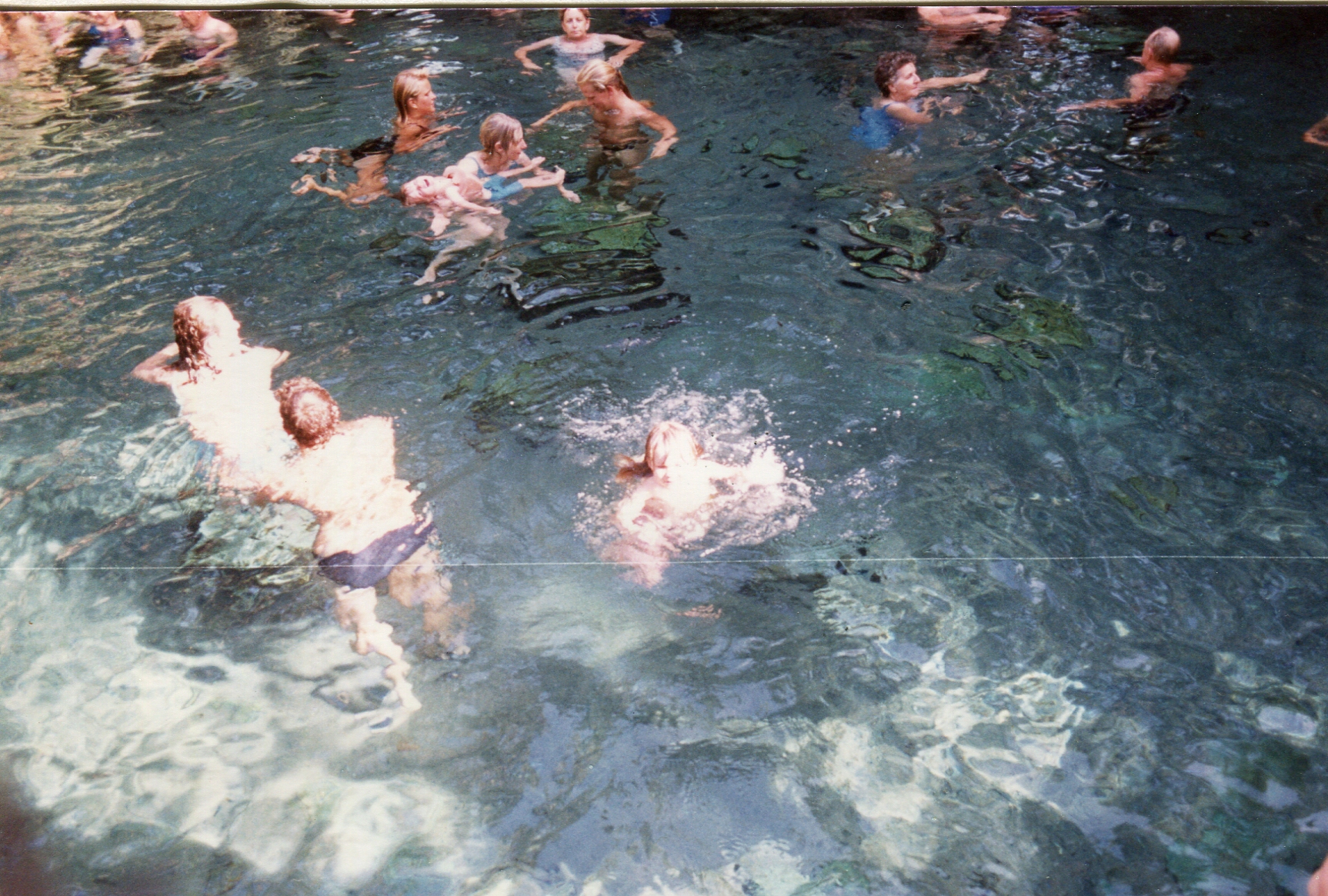
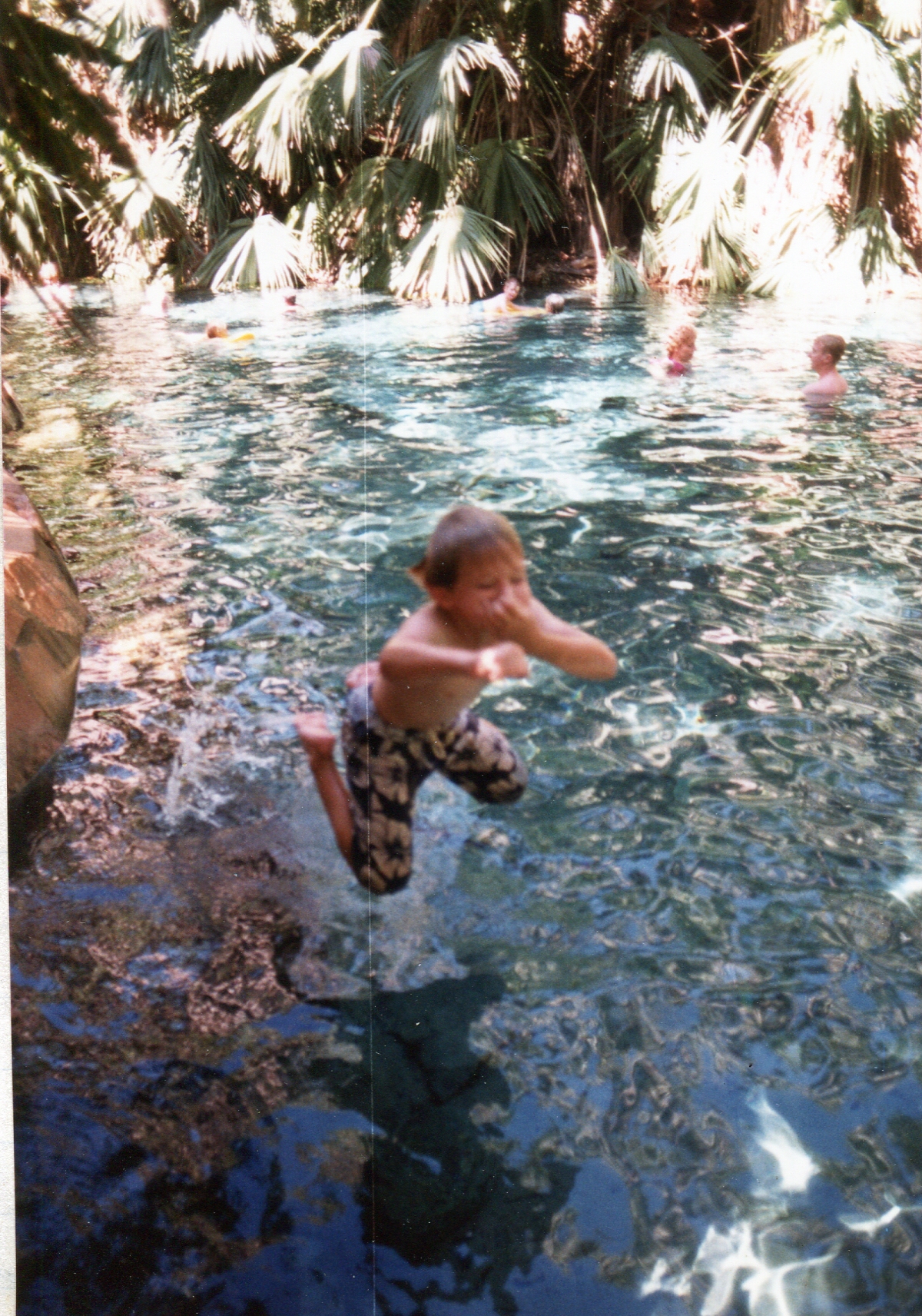
There was a constant stream of people coming and going from the nearby camping ground ($8 per head per night which would have made it almost twice the $21 we paid for the most expensive campsite of the trip at Inverloch Victoria). The people also came from a constant stream of tourist coaches.
Before heading back to our camp on the Roper River, Jacqui did our washing in one of the Mataranka commercial caravan park’s washing machines ($2 per load).
That night we charged our video battery from a nearby camper’s generator. We were given 2 fresh catfish, which had been caught on set lines in the river. Our meal of kangaroo meat stew, bought, frozen, at a Darwin supermarket, was cooked over an open fire - the first time we had cooked that way in a long time.
Wednesday, 16th May 1990
Cloud cover during the night had kept temperatures high and, at times, we were uncomfortably hot. Next morning a combination of lack of sleep, the heat, flies, flies and Lachlan’s lack of cooperation with his correspondence lessons made up our minds for us (did I mention flies?): we would pack up go on to 3 Ways as the first part of our journey to the Coastal Queensland.
Having made this decision at 10 AM, we were on the road by 11 AM. Just as we turned left on the Mataranka Road we saw David, Jackie and Mari pass in their yellow combi, heading in the opposite direction to the hot springs.
At Mataranka we bought the usual and turned south for a long day on the road. At Daly Waters we had lunch and phoned Lell and the credit union. Lell was amazed that we still had 400 km to go, even at 2:20 PM (so was I!)
Next stop, after hours of boring scrub which had simply got thinner as we went south, was Elliott. Here Jacqui walked 1 km to post some letters and we were treated to a verbal brawl amongst some aboriginals up and down the 500 m length of the main street.
Shortly after, with Jacqui at the wheel, we suffered a blow out, the same wheel and the third flat tyre for the van on the curb side. The tiye was totally destroyed, and we were feeling black. It was then that David, Jackie, Mari and their Combi along with Anne-Marie and Nick in their panel van pulled up. It was great to see them and they injected some much-needed humour into the situation. They feel as we do - they have had enough of heat, flies and mozzies. A nice cool beach is needed.
We left them a few kilometres down the road at a roadside rest area where they were spending the night. I got some video footage of them all doing a weird dance to ward off the flies.
At about 8 PM the high beam switch packed it in again. Consequently we arrived at 3 Ways later than we would have preferred, at around 9 PM. As I write this diary entry, just before bed, we are camped 20 m from a water tower that is noisily overflowing and a busy truck stop. Should be a peaceful night!
Thursday, 17 May 1990
Frustratingly, our first stop was at Tennant Creek, in the opposite direction to that in which need to go. During the early morning, before everyone else was up, I worked on the car. I was not able to fix the high beam switch this time. I had more success with the van though, as I think I have discovered and repaired the cause of our frequent flat tyres. The backing plate for the brakes, on the curb side wheel, has bolted to it another plate through which the brake actuation lever passes. This second plate floats. The bolt holding it in place was loose allowing it to move sideways, which in turn caused the brake to drag, adding to the heat build-up in the tyre, and probably worsening our fuel consumption as a result.
At Tennant Creek, we got a retread as a spare tyre for the van, bought food, lollies, ice, ink and fuel. We were out of luck at the car wreckers as they did not have a replacement headlight dip switch.
Just a few kilometres north of Tennant Creek we passed David, Mari, Jackie and Anne-Marie and Nick as they headed south to Ayres Rock and the Alice. I hope they look us up when they passed through Sydney.
The 640 km we covered today seemed to take forever. It was hot and ,at each stop, we were besieged by flies. The countryside was flat with sparse vegetation and ants’ nests dotted everywhere. It was during this leg of our trip that we had to use the jerry can of spare fuel – the normal tank did not have enough fuel to travel between 3 Ways and Camooweal.
Crossing the border into Queensland was more than symbolic: the road narrowed and became very bumpy. Cattle grazing had reduced much of the land on either side of the road to barren, pebbly ground.
At Camooweal we filled with just enough fuel to make Mount Isa. (2020 note: I’m not sure why I didn’t include this in the diary, but we recall Camooweal as a place where, in the early afternoon on a Thursday, there were no shops open for us to buy food, ice creams or drinks. If you ask Jacqui what she thinks of Camooweal be prepared for a long and not very flattering description!).
The last 50 km was the worst stretch of road we had seen, not helped by fading light, speeding buses and road trains heading in both directions.
Our first sight of Mount Isa, just after dusk, was an impressive one: huge smokestacks, belching smoke, illuminated by sodium vapour lamps. Rohan even woke up in a good mood as he sighted this vista.
Links to other posts
In the beginning: Motivation and Planning
NSW: Merry Beach, Bournda State Recreation Area
Victoria Pt 1: Mallacoota - Lakes Entrance, Lakes Entrance - Melbourne
Tasmania: 1st - 18th February, 19th - 27th February
Victoria Pt 2: 28th February - 12th March
South Australia: 13th March - 27th March
Western Australia Pt 1: 28th March - 17th April
Western Australia Pt 2: 18th April - 5th May
Northern Territory: 6th May - 17th May
Queensland Pt1: 18th May - 31st May
Queensland Pt 2 to Sydney: 1st June - 20th June
1 From Stace -
"Spectacular conglomerate" Just brilliant Ian. xx